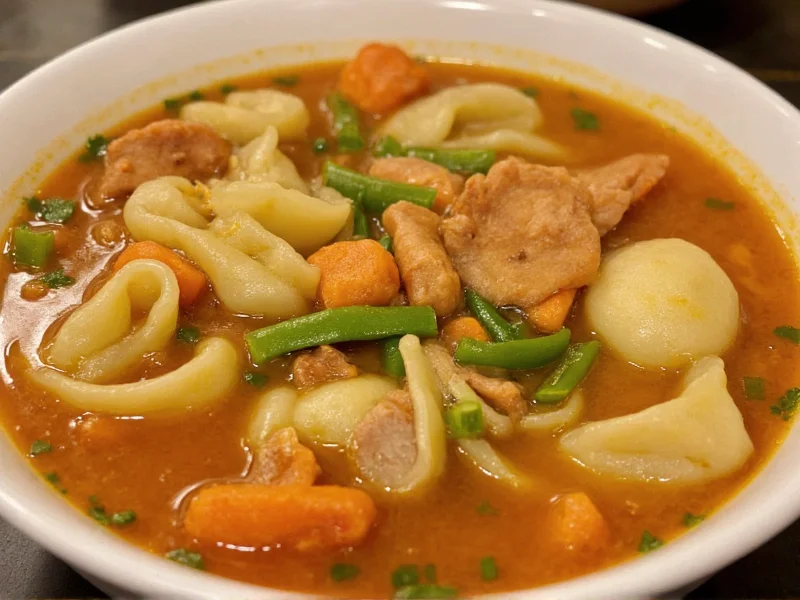The Global Tapestry of Dumpling Soups
Dumpling soups represent one of humanity's most universal comfort foods, appearing in nearly every culinary tradition with remarkable regional variations. These dishes solve a fundamental cooking challenge: how to create a complete, nourishing meal using simple ingredients that can be stretched to feed families. The combination of dough-based dumplings in broth provides carbohydrates, protein, and hydration in a single vessel—making it practical for cold climates, resource-limited settings, and celebratory occasions alike.
Historical Roots and Cultural Significance
Archaeological evidence suggests dumplings in soup form date back to the Silk Road era, with preserved dumplings discovered in China's Turpan region dating to the Jin Dynasty (265-420 CE). These early versions likely traveled along trade routes, adapting to local ingredients and preferences. In Eastern Europe, dumpling soups like Polish żurek developed as practical solutions for using up stale bread and available meats. Jewish communities created matzo ball soup as a Passover-friendly option when leavened bread was prohibited. Each culture transformed this basic concept into something uniquely meaningful—whether as holiday centerpieces, healing remedies, or everyday sustenance.
| Cuisine | Dish Name | Key Characteristics | Cultural Occasion |
|---|---|---|---|
| Chinese | Wonton Soup | Thin wheat wrappers with pork/shrimp filling in clear broth | Year-round comfort food |
| Jewish | Matzo Ball Soup | Matzo meal dumplings in chicken broth | Shabbat and Passover |
| Polish | Żurek with Dumplings | Sour rye soup with potato dumplings | Easter celebrations |
| Korean | Mandu-guk | Kimchi-based broth with meat-filled dumplings | New Year's Day |
| Italian | Tortellini en Brodo | Meat-filled pasta in capon broth | Christmas tradition |
Anatomy of Authentic Dumpling Soup
Creating exceptional dumpling soup requires attention to three critical components: the broth, the dumplings, and the finishing elements. Traditional broth preparation involves simmering bones, vegetables, and aromatics for hours to extract maximum flavor and collagen. The dumpling dough must balance elasticity and tenderness—too dense and they become gummy, too delicate and they disintegrate in the broth. Many cultures employ specific techniques: Chinese chefs create paper-thin wonton wrappers through precise rolling, while Jewish cooks beat matzo ball batter to incorporate air for lightness.
Mastering homemade dumpling soup techniques begins with understanding ingredient interactions. For clear broths, chefs clarify stocks by slowly heating then straining. When adding dumplings, the broth temperature matters—adding them to rapidly boiling liquid can cause breakage. Many traditional cooks prepare dumplings separately then add them to individual bowls before ladling hot broth, preserving their integrity. This approach works particularly well for delicate varieties like Italian tortellini or Chinese xiao long bao dumplings.
Regional Specialties Worth Exploring
While many recognize basic dumpling soup varieties, numerous regional specialties offer unique experiences. Georgian khinkali soup features large, twisted dumplings filled with spiced meat and broth that diners sip through a small opening. Central Asian manti soup presents steamed dumplings floating in tangy tomato broth with yogurt. Mexican sopa de albóndigas combines meatball-like dumplings with vegetables in a tomato-based broth—a dish with surprising Moorish influences. Each variation tells a story of migration, adaptation, and culinary innovation.
Vegetarian dumpling soup options have gained popularity while maintaining authenticity. Many traditional recipes already offer plant-based versions: Chinese chefs create mushroom and vegetable wontons, Polish cooks prepare potato pierogi for meatless żurek, and Korean home cooks make kimchi-free mandu for Buddhist temple cuisine. The key to satisfying vegetarian dumpling soup lies in building umami depth through dried mushrooms, seaweed, and fermented ingredients rather than relying solely on meat-based stocks.
Modern Interpretations and Practical Tips
Contemporary chefs continue evolving traditional dumpling soup recipes while respecting their roots. Some innovative approaches include using alternative flours for dietary needs, incorporating global spice profiles, or presenting deconstructed versions. However, the most satisfying homemade dumpling soup techniques still emphasize patience with broth preparation and careful dumpling construction.
For those learning how to make dumpling soup from scratch, start with manageable projects. Try simple matzo ball soup using store-bought broth initially, focusing on perfecting the dumpling texture. When ready to advance, attempt making wontons with pre-made wrappers before graduating to handmade dough. Remember that authentic dumpling soup preparation values process over speed—many traditional cooks prepare components separately then assemble just before serving to maintain optimal texture.











 浙公网安备
33010002000092号
浙公网安备
33010002000092号 浙B2-20120091-4
浙B2-20120091-4